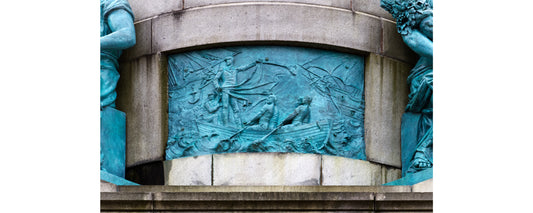Don’t touch the art, a sign warns—except for Hương Ngô’s books, which you must touch in order to read them. First, don a pair of vinyl gloves from the front desk at NXTHVN. Then press your hands on the black printed blocks of Ngô’s pages. When you lift them, you’ll be allowed a brief glimpse into the hidden text below. It tells of the world of Indochinese concubines as portrayed in French colonial congai novels, which describe the system that “bound indigenous women to French men.”
Tous me détestent, I read before the words are swallowed again by the black page. I know enough French to understand this much: Everyone hates me.
This is more than a parlor trick. Because of the need for the viewer’s touch, Ngô’s five handbound books and an accompanying series of four portraits, together titled Reap the Whirlwind (2018), are perhaps the most intimate works in Material Intimacies. The new exhibition at NXTHVN, curated by fellows Michelle Phương Ting and Claire Kim, “brings together artists who materialize, or make tangible, intimacies forged and ruptured by colonialism,” NXTHVN says. The aim is to offer “a path to healing, one that restores the humanity of the colonized and yields new narratives of power and communion.”
sponsored by
There is something protective about the black shield that hides not only the words in Ngô’s books but also the bodies and faces in his serigraphs—silk-screened prints of Indochinese women originally pictured on colonial postcards. The women appear only as ghostly images glimpsed from the side. Approach them head-on and you’ll be met with a black canvas. Walking back and forth as if to peek through the crack between two curtains, you’ll pick up details: bare breasts, a serpent worn like a boa. And you’ll see their eyes, gazing solemnly. This was a real woman, I think, studying one of them. And I have already put my hands all over a version of her story. Those handprints—both mine and those that came before mine—linger inside the books long after we have walked away.
You must step through an actual curtain in order to view Zina Saro-Wiwa’s video Eaten by the Heart (Documentaries) (2012-2013), which begins with a series of interviews on the inquiry, “How Do Africans Kiss?” The question provokes quizzical expressions, contemplation and laughter from its Black subjects, all of whom give surprisingly similar answers: Africans kiss privately, chastely, slowly. A second short clip documents a young Black man’s face as his eyes redden and water before tears spill down his cheeks.
But it was Part III of Saro-Wiwa’s piece, “Breathing Orchestra,” that mesmerized me most. Video portraits appear on a single field like vertical postcards (blessedly and accidentally distinguishing them from a horizontal Zoom screen). They’re introduced one by one along with the narrated stories of these people of color—intimate stories specific to race. Their portraits’ edges overlap and their voices layer until a cocktail party’s worth of sound hushes into the sound of every person breathing. Eyes closed, they breathe deeply, as if calming themselves, and you can’t help but notice that you are breathing, too. There’s a sense of community, comfort, belonging. For several minutes—or so it seems—you breathe together, until the portraits fade off one by one. The last man left on the screen opens his eyes, and the intimacy is severed.
Many of the pieces in Material Intimacies are similarly meditative. The exception is the work of artist Yvette Mayorga, whose cupcake icing-colored acrylic piping tells similar stories of disruption and loss with bolder strokes. Homeland Promised Land (2019), for example, is painted on a circular canvas—an oversized U.S. Homeland Security badge—of crazed American consumerist imagery. Flanked by two orange soda bottles labeled “Fake,” the painting’s central figure, wearing a Gap T-shirt, is shackled with gold chains and hooded by a huge layer cake. Like a 21st-century version of the Sistine Chapel ceiling, this imagined scene appears on a backdrop of clouds, with cherubs presenting their backs to us, their hair weaving into the nest of a baby eagle. Two bikini-clad figures prepare to whoosh down a pair of pink chutes, heading for a pair of fairy tale lovers. The whole scene is clutched by two skeletal hands. It imbues the words “Homeland Security,” painted around the bottom of the piece, with new meaning; this hypercharged, fake-sweet homeland offers the opposite of security.
On the exhibition’s opening panel, a quotation from the poet Layli Long Soldier reads, in part, “It’s here we roll along the pavement into hills of conversation we share a ride we share a country but live in alternate nations…” Many voices speak at once in Material Intimacies, overlapping like the voices in “Breathing Orchestra.” Perhaps some of them will help us to see and to talk about those “alternate nations.”
Material Intimacies
NXTHVN – 169 Henry St, New Haven (map)
Wed-Sun 2-6pm and by appointment through January 18, 2021
hello@nxthvn.com
www.nxthvn.com/calendar/material-intimacies
Written and photographed by Kathy Leonard Czepiel. Image 1 features a sidelong view of portraits in Hương Ngô’s Reap the Whirlwind (2018). Image 2 features Yvette Mayorga’s Homeland Promised Land (2019).








